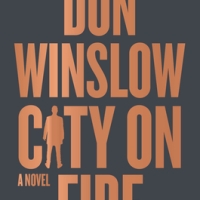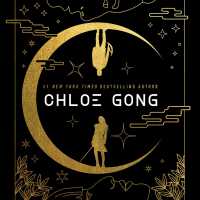Top Ten Tuesday: Horror, Fantasy, and Science Fiction Books Featuring Killer Plants & Fungi
Top Ten Tuesday was created by The Broke and the Bookish, a weekly meme that now resides at That Artsy Reader Girl. The meme first came about because of a love of lists. Who doesn’t love lists? The original creators also wanted their lists to be shared with fellow book lovers and to ask that we in turn share ours with them and connect with other book bloggers. To learn more about participating, stop by their page dedicated to it and dive in!
This week’s topic: Freebie!
Mogsy’s Picks
Spring finally feels like it’s here, so in honor of the beautiful plants and flowers that are blooming all around us, I’ve decided to celebrate by using this freebie week to showcase a list of books featuring my favorite and most interesting (or scariest) deadly botanicals. Hopefully everyone’s enjoying the warmer weather and having fun spending more time outdoors. Try not to worry about that innocent little shrub growing in the corner, it’s not going to sneak up on you or anything.
 Day of the Triffids by John Wyndham
Day of the Triffids by John Wyndham
Probably the most well known sci-fi novel about killer plants, this classic features the Triffids, a tall and mobile poisonous plant species whose origins are never fully revealed, but speculation has ranged from bioengineering to extraterrestrials. Whatever the case, I think everyone can agree they’re nasty creatures. Towering at over seven feet tall, they move by propelling themselves on three blunt leg-like appendages, using their venom-filled stinger to attack and subdue its prey. Their poison kills on contact, after which the Triffid can root itself on the corpse to feed at its leisure, drawing nutrients as from the body as it decomposes. Yuck.
 Harry Potter series by J.K. Rowling
Harry Potter series by J.K. Rowling
Fans of fantastical plants and fungi will find a treasure trove of them in the Harry Potter series, from the Mandrake, a plant with a root that looks disturbingly like a human and whose cry can be fatal to anyone who hears it, to the Whomping Willing, a violent tree that will attempt to pummel anyone or anything that comes near its branches. Other plants with dangerous or unpleasant effects include the Mimbulus mimbletonia, a cactus-like plant with boils instead of spines that when burst will spray stinking goo all over anyone unfortunate enough to be nearby; the Snargaluff, a carnivous plant which will disguise itself as a dead tree stump in order to lure out its unsuspecting prey; as well as the Devil’s Snare, a constricting vine that will strangle anyone caught among its tendrils and will only squeeze tighter the more its victim tries to struggle.
 The Girl with All the Gifts by M.R. Carey
The Girl with All the Gifts by M.R. Carey
The Girl with All the Gifts is a zombie book, featuring a world that has been infected by a variant of the Ophiocordyceps unilateralis fungus. Originally known to parasitize only insects, somehow a strain of this fungus has evolved to attack humans, making those it infects lose their mental powers and develop a taste for human flesh. The disease spreads through bodily fluids including saliva and blood, hence a person can be infected by a single bite. Over time, the fungus will also take over the host from within and sprout a fruiting body which will release its spores into the atmosphere, spreading the infection to more healthy humans thus creating more “hungries”.
 The Rains by Gregg Hurwitz
The Rains by Gregg Hurwitz
Another book that plays on the Ophiocordyceps unilateralis idea, The Rains begins with an introduction to the quiet and rural community of Creek’s Cause, where the peace is shattered one evening by a meteor strike. Not long afterwards, our fifteen-year-old protagonist Chance and his older brother are awakened in the middle of the night by a commotion at their neighbors’ house, leading the two of them to sneak out and investigate. They arrive just in time to stop an attack on some kids by their stepmother, who appears to have been transformed into mindless raving husk by a mysterious and unknown parasite. After saving the children, Chance finds his neighbor on top of a water tower where millions of alien spores look to have exploded from out of his bloated corpse. Funny thing about the Cordyceps fungus in this book though, is that they only infect adults, sparing the young. But as soon as you turn 18, watch out! Yeah, that doesn’t make a lot of sense to me either, but since when do killer fungi follow the rules of logic?
 Semiosis by Sue Burke
Semiosis by Sue Burke
Semiosis is a multi-generational story that takes place over the course of many years, following a group of human colonists who have traveled light years from Earth to settle on a planet they dubbed Pax. However, they were wholly unprepared for the alien environment that awaited them, nor did they anticipate Pax’s bizarre plant life and the surprising ways it interacted with the surroundings. Many of the original settlers died within a matter of weeks, some because they ate fruits that they previously thought were safe. But through hard work and perseverance, the colony managed to survive, giving rise to the next generation. Still, certain sentient plants on Pax continued to behave in dangerous and unpredictable ways, manipulating the animal life around them to challenge the humans.
 Uprooted by Naomi Novik
Uprooted by Naomi Novik
The protagonist of Uprooted is Agnieszka, just another simple girl from yet another simple village, but the bucolic setting belies something more sinister lurking beneath the surface. Surrounding Agnieszka’s valley home is the ever encroaching Wood, a forest filled with dark energies and spirits, whose corrupting force has trapped and stolen the lives and minds of many. Author Naomi Novik uses vivid imagery and “traditional” magic (the kind you would find in classic fairy tales) to create the idea of the spiteful and malignant living forest, so that the entire Wood itself becomes a formidable and terrifying villain.
 The Genius Plague by David Walton
The Genius Plague by David Walton
This is another book about a fungal plague, but unlike the examples above, it has a twist. Let’s face it; in most stories, being infected by a fungus is usually bad—like you can be turned into a mindless zombie, for example. Yet in this case, the fungus actually makes you smarter, though things don’t turn out so well for the humans in the end either. While conducting research deep in the Amazon rainforest, our protagonist Paul Johns picks up a lung infection from breathing in the spores of an unknown species of fungus. Back in the United States, he is treated for his pneumonia and recovers, though afterwards, it appears that the fungus had altered his brain functioning as well, improving memory centers and enhancing pattern recognition and communication skills. Excited about what this could mean for the human race, Paul believes that a symbiotic relationship with the fungus is the next step in human evolution, but his brother Neil, a little more circumspect, is not entirely convinced that joining with an unknown organism would be in humanity’s best interest.
 The Tangled Lands by Paolo Bacigalupi and Tobias S. Buckell
The Tangled Lands by Paolo Bacigalupi and Tobias S. Buckell
This collection of four novellas take place in a shared world taken over by a fast-growing kind of bramble that feeds on magic. It also poisons the soil so that nothing can grow without making people very sick. As a result, the once great city of Khaim has turned into a crumbling ruin, and any kind of magic has been outlawed to prevent the bramble from encroaching any further. The stories here all feature characters who have been affected by the bramble in some way, like the alchemist whose daughter has a fatal lung disease from being infected with the bramble’s seeds, or the young man whose sister has succumbed to “bramble sleep”, a type of coma caused by the deadly plant.
 The Mirror Empire by Kameron Hurley
The Mirror Empire by Kameron Hurley
I wasn’t a big fan of this book and can’t say I remember much from it, though I have to admit the world-building was pretty cool. We have everything from magic linked to satellites to female warriors who ride bears and dogs, but the thing that has stuck with me the most are the murderous trees. If you ever find yourself in the world of The Mirror Empire, best watch your step because you never know when you might run afoul of the semi-sentient trees and another carnivorous plants that won’t hesitate to gobble you right up.
 The Ruins by Scott B. Smith
The Ruins by Scott B. Smith
I might be fudging it a bit here, since I can’t recall if I really read this book or what I’m remembering is from the film adaptation (both came out a while ago). The story follows a group friends vacationing in Mexico, and they become trapped in the jungle after one of their group goes missing and the others decide to go look for him. Our hapless characters then come upon some ancient ruins, covered in what appears to be a bunch of your run-of-the-mill jungle vines – except they’re very wrong about that. In fact, these vines are deadly and feed on human flesh. Worse, if one of their tendrils come in contact with an open wound, they can infect their victim and germinate their spores from within the host’s body. I’m shuddering just thinking about it.













Haha this is such a fun idea…loved all your answers! XD
LikeLike
Thanks! I had fun putting this post together.
LikeLiked by 1 person
*takes notes* (After all, I am studying infectious diseases including fungi IRL right now… clearly, I need to keep an eye out.)
LikeLike
Haha, I think many of these would be very fun for you then 😀
LikeLike
I love killer plants and I need to read Day of the Triffids stat! I’ve been meaning to for a while. I liked the Rains, except for the 18 age cutoff which seemed silly. The Ruins sounds like a trip! Oh and Invasion of the Body snatchers- I know they’re probably not plants per se, but the whole pod thing- freaky!!!
LikeLike
Yes, I believe in The Invasion of the Body Snatchers, the creatures were plant-based! I haven’t read it, but it would be a great addition to this list!
LikeLike
Well, THAT is definitely an interesting topic 😀
I totally don’t remember the murderous trees in ‘The Mirror Empire’. That being sad, I am forgetting more and more (not the bear and dog-riding!) and think I should pick up book 2 soon.
LikeLike
LOL, it was the only thing I recall vividly from that book. I didn’t really enjoy the story, but I do remember the killer trees!
LikeLiked by 1 person
Ooh wow! That’s a cool topic! And look at these picks! So awesome! Yay for a Harry Potter book too!
Here’s my Tuesday Post
Have a GREAT day!
Old Follower 🙂
LikeLike
Oh yeah, Harry Potter was definitely being included 😀
LikeLike
What an awesome and unique topic. I need a classic SFF book for a challenge this year and I think I may now pick up Day of the Triffids. Would you recommend it for that slot?
LikeLike
Yes, I would! Though if you want to try Wyndham, my favorite book of his was actually The Chrysalids!
LikeLike
Such a neat take on the topic. Happy reading!
eli @ the (book) supplier
My TTT
LikeLike
Thank you! Happy reading to you too!
LikeLiked by 1 person
Definitely an interesting choice! I was trying to remember if Gleam by Tom Fletcher would fit, or if its just the animals that are bizarre. There is also Dark Eden.
LikeLike
Actually, in Dark Eden the plants dont kill. At least not that I remember. Quite the opposite I think.
LikeLike
Yeah, there were all sorts of interesting and unique plant life on Eden, but I don’t think any of them were deadly 😀
LikeLike
since your review I really want to try the Carey one
LikeLike
That one’s great! Definitely put it on your tbr 🙂
LikeLike
This is such a cool topic! And HP is a really good one!
LikeLike
Thanks! And yeah, the number of cool and dangerous plants in HP can probably fill several posts 😀
LikeLiked by 1 person
You’re welcme!! hehe yes!!
LikeLike
Killer plants and fungi might abound in sci-fi and horror, and later years have seen a good number of nasty critters peeking from the pages of great books, but still the triffids are able to send a cold shiver down my spine… 🙂
LikeLike
I need to seek out more, I love stories about killer flora 😀
LikeLike
What a great theme – I love books like this and I’ve read a few off here and loved them – I should try to get to all the others too.
Lynn 😀
LikeLike
I’m definitely a sucker for books about this theme, I hope we see more 🙂
LikeLike
This is my favorite TTT this week! Like, super amazing job, Mogsy! ❤ xx
LikeLike
Aw, thank you! I had a great time putting this post together 🙂 Happy reading!
LikeLiked by 1 person
This is a great idea for a list! I was going to do something similar with mushroom/fungi books at some point, although I love that you included killer plants. The Ruins was so flippin’ scary!!
LikeLike
Originally I had wanted to do either plants or fungi, but realized I couldn’t field ten books if I did each individually, so I combined them 😀
LikeLike
The Ruins immediately came to mind for me. I love that book! This is a great list. 🙂
LikeLike
Man, I wish I remembered definitively if I read it or not – maybe I should pick up the book again regardless 😀
LikeLike
I have a copy of The Rains somewhere on my ereader. I read The Ruins and liked the concept but just felt it didn’t fully deliver for me. My dad likes the film though.
LikeLike
I definitely remember watching the film! Probably because of all the gory bits 😛
LikeLike
omg why are there so many?! I need to read Uprooted!
LikeLike
Oh definitely read it, I loved that book!
LikeLike
Yay! Let’s here it for deadly plant life!!! 🙂 I’ve read and loved quite a few of these … Uprooted and The Ruins still to read. Great list!
LikeLike
Thanks! I hope you get a chance to read Uprooted, one of my favorite books 🙂
LikeLiked by 1 person
Pingback: Wrap Up: April 2018 or that was a month. – I have thoughts on books
I remember a book around 2000 about a widower who received some plants in the mail. they sprouted spores and people nearby started experiencing hallucinogenic effects. don’t remember the title though.
LikeLike
Other stories about the topic (from Wikipedia): “Gray Matter”, a short story by Stephen King first published in the October 1973 issue of Cavalier magazine, and later collected in King’s 1978 collection Night Shift, is the story of a man who, having become reclusive after a work-related accident, drinks a bad can of beer and is ultimately overtaken by fungal growth from within.
John Brosnan’s novel The Fungus from 1985 has a similar plot, in which mutated fungi destroy England, and those infected die or become mutated mushroom people, depending on which type of fungus has infected them.
Brian Lumley’s short story “Fruiting Bodies”, which won the British Fantasy Award in 1989, concerns a strange fungus that slowly destroys a town and ultimately consumes the bodies of the last remaining residents, but keeps their form. The story ends ominously as wood from the town has been harvested for use in homes across England, and the narrator has inhaled spores from the strange fungi. Lumley has named “The Voice in the Night” as one of his favourite stories.
LikeLike